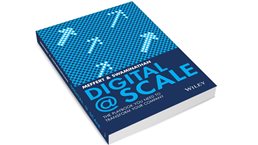There are many facets to a digital transformation. One of the most important parts is getting the organization in shape for digitization. This excerpt, from Digital @ Scale, discusses something the authors call the digital operating system, a way to organize and run your company like a digital native.
Stay current on your favorite topics
To switch your business to digital, three fundamentals are needed: (1) Recruit a team that’s as enthusiastic as it is technically proficient. (2) Prioritize speed above perfection. (3) Introduce milestone-based project management in the style of the venture capitalist.
Recruiting and expanding the team
Data scientist, IoT software developer, user experience design expert, product owner, scrum master. These are job titles from the digital world. But do you know what the job titles actually mean, or what drives these people? Two things are certain: they’re needed and there aren’t enough suitable candidates. Where can they be found, and how can they be recruited?
Job fairs have only limited success. Above all, digital natives need to be lured by exciting and meaningful work through the channels where these new, mostly young, stars of the future spend most of their time. Social media, blogs, and start-up conferences are good places to start. Use the new formats like hackathons and start-up competitions to get to know digital natives. Be present at the leading digital events and conferences such as the Consumer Electronics Show (CES), Disrupt SF Hackathon, South by Southwest (SXSW) Interactive, LAUNCH Festival, or competitions within academic institutions such as HackMIT and the UC Berkeley start-up competition.
These are all good opportunities for traditional enterprises. Digital talent isn’t put off by a big corporate name, but by a dull job profile or the lack of concrete challenges. Recruiters need to weave interesting stories and stoke enthusiasm for the new work ahead. Potential candidates are generally attracted by authentic values and strong corporate stories. Interviews should be conducted by top-level managers, even as high as the CEO, people who exude the passion needed to attract talent and build the fledgling employer brand. Finally, the company must strive at least as hard as the candidates to present itself as an appealing prospect in order to fend off the attractive employers who top all the relevant rankings.
Skilled digital natives love ambitious projects and big ideas. They want to rewrite the future of industrial robotics and automation rather than simply optimize the logistics processes in a plant. For recruiters, that’s often only a matter of tone. The recruiters themselves should also be part of the digital community and not come across as people from a distant planet. This is a challenge that many HR departments often find overwhelming. There are specialist agencies and freelancers who can step in to fill this gap, at least for the early setup phase. An experienced digital recruiter, then, must be right at the top of the list of recruitment targets.
Would you like to learn more about our Digital McKinsey Practice?
If, despite all the good advice, companies still fail to put together a digital team, they can just go ahead and buy one instead by acquiring a start-up with all the necessary talent. One prominent example is Walmart. In 2011, the retailer paid $300 million to acquire the social media company Kosmix.
And since it’s so difficult to find talent, it’s even more important to retain it. Work must be challenging and future-focused, and the working environment must be appealing, with open working areas in attractive locations. Creativity is inversely proportional to the number of restrictive walls. Training and one-to-one coaching must also be on the table, as well as intensive mentoring and personal development plans for each individual.
However, it’s wrong to assume that all open positions must be filled with experienced digital talent only. Companies need to learn to develop talent themselves. They need to be open to young people and, more than ever, to recruit by potential rather than references and reputation. Companies should be able to give everyone in their organization the opportunity to experience and learn the new digital technologies, and this includes providing the space for talent to develop naturally. Google, for example, gives its employees the freedom to spend up to 20 percent of their time working on their own chosen tasks, and 3M introduced a similar measure years ago.
Ability to establish fast concept iteration
Fast concept iteration is something that Steve Jobs believed in. When the Apple founder launched the first iPhone in 2007, it still only used the slow Global System for Mobile (GSM) transmission standard even though his rivals were using the faster Universal Mobile Telecommunications Service (UMTS). The early iPhone couldn’t even receive GPS signals for satellite navigation. Digital natives refer to it as the minimum viable product (MVP), a product that offers only the minimum possible number of essential features. For the product to be a success, it needs to address a pain point, a place in the market where customers encounter problems. With its touch-screen design, Apple displaced number pads and keyboards and hit on one such pain point. With Apple’s open interface, a rapidly growing range of apps soon followed that could be downloaded to the device, thus greatly increasing the appeal of the iPhone. Customers did the rest: the Apple engineers fed reactions and comments of customers back into development virtually in real time, and before long they had the most popular smartphone in the world.
Companies pursuing a digital transformation should adopt the MVP approach even if it means their engineers and designers will need to rein in their quests for perfection. It prevents expensive and protracted product development based purely on assumption. US innovation guru Steve Blank even goes so far as to encourage businesses to see the customer as a partner in the product development process. Early adopters in particular should be seen as kindred visionaries and should be utilized. However, companies still have to identify a particular pain point for the first version of the product, which is no easy task.
Even Lufthansa followed the MVP route when it digitized its check-in process. This critical core process was adapted to the technological possibilities and customer needs over several stages, following a continuous and iterative method. Time and time again, a crucial question had to be answered: How much change are passengers willing to accept? Nonetheless, the airline had identified a real pain point—standing in line in front of a check-in counter has always been one of the downsides of flying.
As a first step, Lufthansa installed check-in machines, where friendly employees were on hand to help passengers with any problems. Customers welcomed the service. In the next stage, the airline offered customers the option of checking in at home on a PC and printing out the boarding card themselves. The move promised more convenience and was only one step removed from using the check-in machines. Again, customers welcomed it. It also meant that Lufthansa was able to significantly reduce costs since the customer now provided the necessary hardware. And as the process went mobile with the spread of smartphones and apps, the digitally attuned Lufthansa customers could now free themselves of the PC and printer altogether and simply scan the boarding passes on their smartphones.

Digital @ Scale: The Playbook You Need to Transform Your Company
The process is far from over, however. Just as with lean production in the past, continuous improvement is the order of the day. Lufthansa rival KLM, for example, as one of the first partners of Facebook, uses a chatbot on Facebook Messenger as a new channel for communication and interaction. KLM customers can now call up their digital boarding cards on Messenger. The service also means that KLM can provide its passengers a far more personalized offering via Facebook. Just like WhatsApp, travelers receive a push notification telling them they can now check in or notifying them of any changes. The development has personalized the check-in process.
A key component of the digital operating system is its specific ways of resolving problems. If digital companies want to redevelop or improve products or processes, they tend to rely on design thinking. This is where cross-disciplinary teams tackle problems by using the classic methods of designers: observe, understand, develop ideas, translate quickly into prototypes (rapid prototyping), test on the market, and immediately feed customer reactions back into product improvements. The aim is to produce a simple solution that is also simple from the point of view of the customer. After all, the solution is ultimately being developed from the customer’s perspective and for the customer’s benefit.
Above all, the customer interfaces must be as simple and intuitive as possible. The mobile apps of today will likely become the voice-based interfaces of tomorrow. Voice assistants like Alexa from Amazon, Google Home, or Apple’s Siri provide simple and intuitive input options that are much easier than screens and keyboards. Online retailers are developing checkout processes that enable the customer to complete purchases in a single click rather than through multiple steps. Digital natives like PayPal and Amazon already offer this. There are other examples of innovative design concepts that are focused on the needs of the customer and that radically simplify the buying process. One of these is Amazon’s Dash Button, which allows customers to order replenishments for frequently used items like laundry detergent with just the push of a button.
To anchor design thinking in the innovation and product development process, management itself must understand these technologies, and ideally have experience with them. Participating in hackathons—team events geared toward the shared improvement of a digital process—is a good starting point. An effective exercise is for a team member, for example the manager, to play the role of the customer and always argue from the customer’s point of view. Although all companies claim to focus on the customer, too often the customer’s voice is overlooked or taken into consideration only at the end of the process.
Establish steering by milestones
What marks a digital enterprise? The fact that it forms fact-based hypotheses and takes data-driven decisions. To come by these facts, new data needs to be collected, whether self-generated or acquired from third parties. Companies should therefore ensure they always follow measurable targets—for example, reducing process costs or increasing customer acceptance, conversion rates, or process speed. Naturally, multiple targets can be pursued at the same time. These targets must be anchored with KPIs with meaningful metrics defined for each process to be digitized. The targets for the milestones to be achieved can be derived either from the company’s business targets or from benchmarking. The targets and the actual results on the given dates are then reconciled to determine whether the milestones have been hit.


